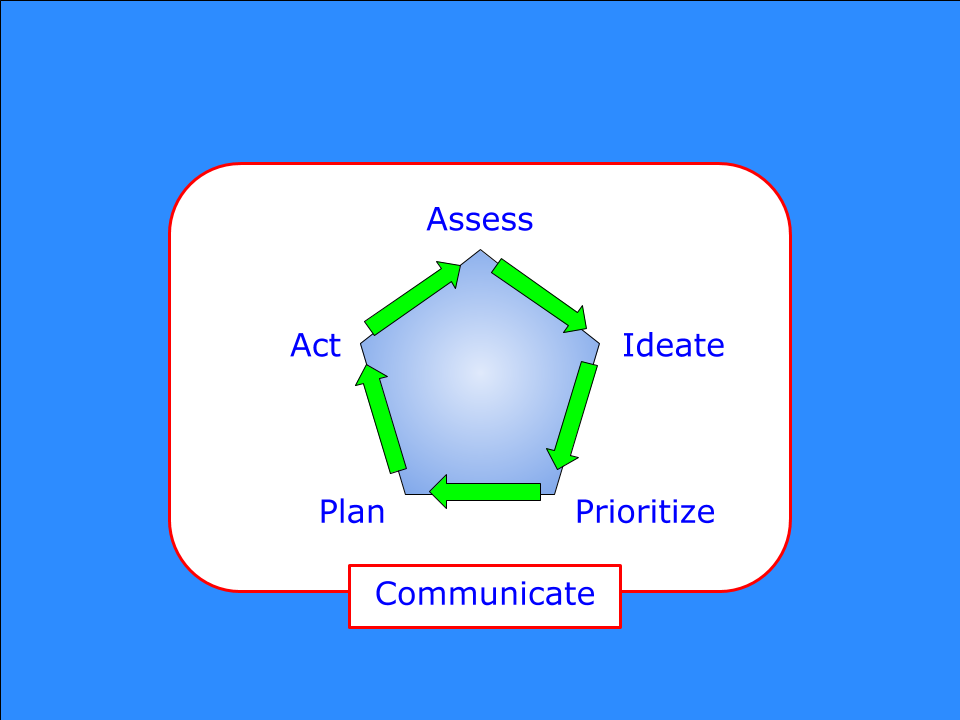Introduction
Depending on where you live and when you started counting, we are now (mid-June, 2020) in the fifth or sixth month of the COVID-19 pandemic. There are signs of progress, including promising work to develop a vaccine. But many areas are still seeing increased infection rates. It appears that the pandemic is far from over. At the same time, a lot of attention is now focused on “reopening” – allowing businesses open their doors to customers, allowing employees to come back to offices, and letting kids go back to school. This presents a major planning challenge for managers.
When we talk about the pandemic, we often mention “the new normal”. This phrase reflects an understandable desire to reach a new place of stability and certainty. We want to get out of self-imposed (or government imposed) isolation and establish new routines. We know we can’t go back to life and work as it was before the pandemic, so we look ahead to something different.
But instead of a new normal, I think we should be preparing for the next normal. For years we’ve told ourselves that “the only constant is change”. Our current circumstances suggest that is more true than we could imagine. Speaking about the COVID-19 pandemic, Raj Kumar, the CEO of Devex, an information services company serving the global development community, puts it this way:
“Most people want to say, ‘This crisis [the pandemic], it’s a black swan event. In the world of Devex, we did not view it that way. Crisis is the new normal. Disruption is the new normal.”
Another leader in world health, Mikkel Vestergaard, recently published an article on the World Economic Forum web site titled “Pandemics are here to stay”. He says
“The spread of coronavirus was hardly a surprise, and certainly not an anomaly. Population growth and increased mobility has led to rapid transmission of pathogens globally. We are now seeing new, deadly viral outbreaks almost every year…This is our new normal.”
In this world view, whatever “normal” we arrive at next will be temporary, to be replaced later by another normal, then another.
We’re Living in a VUCA World
Earlier this year, before the widespread outbreak of the coronavirus, I wrote about the challenges of managing in uncertain times. Since then, we have experienced uncertainty on unprecedented levels. In addition to the global pandemic, we are experiencing massive unemployment, an economic recession and protests for racial equality in many cities around the world. We are now living in what some people refer to as a“VUCA” world, where Volatility, Uncertainty, Complexity and Ambiguity combine to create new challenges as well as new opportunities.
We must adapt our management practices to this new reality. This doesn’t mean we have to anticipate, or accept, a world of continuous chaos. It means that we must orient our thinking to plan for future disruptions and be prepared to react. Better yet, we should proactively think through possible future scenarios so instead of knee-jerk reactions we can make planned pivots.
The team at MindTools.com published an excellent article about managing in a VUCA world. They see adapting to VUCA as a necessary choice:
“In an industry or organization that’s affected by VUCA, you have a choice. Either you allow VUCA to ‘manage’, overload and overwhelm you, or you accept and manage it, so that you and your team can mitigate its effects. When you decide to accept VUCA, you choose to make yourself and your people less vulnerable, and you empower everyone to deal with uncontrollable, unpredictable forces.”
It’s clear that we need a framework for thinking about the future and tools to help plan for it. In this article, and several to follow, I will outline such a framework and describe the tools and processes that managers can use to plan for the “next normal”.
A Framework for Planning for the Next Normal
The framework consists of six phases, each with a specific set of activities. Five of the phases make up a repeatable cycle. They are supported by an ongoing communication phase. The overall objective is to provide a robust and repeatable planning method that can address near-term challenges and long-term uncertainties.

Two Caveats
Before we go any further, let me offer two caveats:
First, there is nothing in the framework that is completely new or groundbreaking. It is based on techniques and tools that have proven valuable to many organizations over many years. I expect you will recognize many of these. You may have used some of them. What you may notice is that they are presented in a different order and context.
Second, this is not an attempt to predict the future. The activities in the framework are oriented to explore future possibilities and translate them into actionable plans that anticipate future events. We want to be prepared for what might happen, but none of us has a crystal ball.
The Six Phases
The phases are: Assess, Ideate, Prioritize, Plan, Act and Communicate. I have summarized each phase below. Additional details will be published in subsequent articles.
Assess. We begin the Assess phase by defining an assessment topic. This could be a problem, issue or opportunity that the business or organization is experiencing now or one that we anticipate in the future. Some examples could be “How can we generate more revenue in our consulting business?” or “What skills and training will we need in our workforce five years from now?”
Other activities in the Assess phase include:
- Organizing a team to do the assessment.
- Evaluating multiple aspects of the assessement topic using analysis techniques like SWOT and PEST.
- Identifying the internal strengths and weaknesses that are related to the topic.
- Identifying future opportunities and threats (internal and external), areas of uncertainty and potential risks.
- Deciding which items identified are the most relevant to addressing the topic.
Ideate. For each of the high relevance items, we will identify actions to address different aspects of the topic. We will use structured brainstorming techniques and will answer several questions, including:
- What should we do to address this item?
- How do we capitalize on our strengths and take advantage of new opportunities?
- How do we mitigate weaknesses and threats?
Prioritize. In this phase, we will review the output of the Ideate phase and decide which of the actions are most important to address first (or next). Depending on the complexity of the topic, we will use one or more decision support tools, like 2X2 matrices or Cause and Effect (C&E) matrices, to determine the relative priorities of the proposed actions. We will also check the degree of alignment between the proposed actions and the organization’s overall mission, vision and objectives.
Plan. This phase should feel very familiar and will utilize processes you probably already have in place. We will determine how to implement the actions identified in the Prioritize activity and identify the measures of success. For each of the prioritized actions, we will ask and answer questions like:
- How should we do it?
- In what order?
- Who will do it?
- What obstacles or interdependencies could impede progress?
- How will we measure progress and success?
Act. Now we implement the plans and monitor the results. We will identify new issues that arise and either resolve them or hold as input for the next planning cycle.
Communicate. Throughout the cycle it is critical that we provide clear and consistent communication. This ongoing activity informs and discusses with your employees, colleagues, leaders, customers, suppliers and other stakeholders about what is planned, what is underway, what has been completed and the results that have been achieved. We will create a detailed communication plan to guide these efforts.
An Iterative Cycle
The framework is organized so that the first five phases – Assess, Ideate, Prioritize, Plan and Act – form a repeatable cycle. Each iteration through the cycle addresses a different problem or opportunity as defined in the assessment topic.
During the first iteration of the cycle, the assessment topic should be something relatively simple that needs to be addressed in the near future. As you gain experience with the framework, later iterations can address more complex topics with longer time horizons.
When the cycle is complete, you can determine when the next iteration should begin. If the changes implemented in a cycle were minor, you may decide to start over immediately. If more extensive changes were put in place, it may make sense to allow time for the organization to absorb and assimilate. Either way it is important to recognize two things:
- First, the value of the framework comes through repetition. Adopting a continuous planning approach will help embed the discipline in your organizational DNA, making it a habit instead of a disruptive annual event.
- Second, each iteration builds on the ones that were done before. Much of the information gathered and insights gained from one cycle will be reused in the next one.
This process is deliberate and rigorous. The framework requires input from a variety of sources and uses that input in ways that are intended to challenge our preconceived notions. It incorporates familiar processes like brainstorming, but conducts them within a structure that helps ensure the result is a comprehensive analysis and not just a compilation of “whatever is on our minds today”.
At the same time, the tools and processes are adaptable – and should be adjusted to fit your specific business situation. One size does not fit all.
What Comes Next?
I have published a series of articles that provide the details for each of the phases. In those articles, I describe the process steps, the techniques used and the supporting tools. Where applicable, I have provided templates and worksheets that illustrate the activities. My goal is to give you the roadmap and the tools you need to assist your planning for your next normal.
Here are links to the other articles in this series:
- Phase 1 – Assess
- Phase 2 – Ideate
- Phase 3 – Prioritize
- Phase 4 – Plan (Part 1 – Developing a Plan)
- Phase 4 – Plan (Part 2 – Refining Your Plan)
- Phase 5 – Act
- Phase 6 – Communicate

Conclusion
We live and work in a time of unprecedented uncertainty, and should anticipate more disruption in the future. As managers, we must use our skills and expertise to help prepare our organizations for those changes. By adopting a rigorous, repeatable planning framework, we can develop and implement plans that address immediate needs while informing our thinking about future challenges. Instead of confusion and chaos, we can help our organizations develop a mindset of possibility and opportunity.
In a recent post on the BoardSource blog, Katha Kissman and Tony Scucci summed it up well.
“Change has always been inevitable. Yet even as the world is rocked with what we feel is uncontrollable, we have far more power to imagine and create and focus on a preferred future than we might believe. If we can dwell in the possible — asking ourselves, ‘What might things look like for our organizations and ourselves on the other side of this pandemic?’— we can envision the future we intend rather than settle with a future by default.“
To your success,

What do you think?
What “next normal” challenges will your organization face? How are you planning for them? What problems are you encountering?
Leave a comment below or send me a note using the Contact Form.
